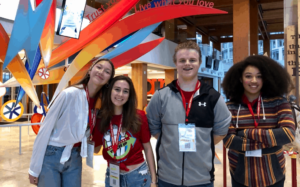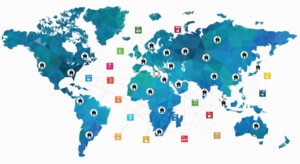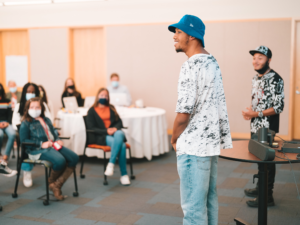Your School Has Left the Building

For a long time, our notion of “school” has been a knotted bundle of assumptions about what’s taught, where teaching takes place, when it takes place, who’s in the room and why, and who gets to decide the what, when, where, and who.
For the vast majority of students pre-pandemic, this meant
- following a district curriculum at a fixed pace,
- in a building owned and operated by the district,
- on a schedule designed by and for adult administrators,
- within a fixed group of kids determined by birthday,
- led by someone assigned according to opaque contract provisions.
Each of these assumptions reinforced one another. They hardened into regulations and requirements, which became practices and customs, which reinforced the original assumptions. Decades of experience show that this bundle serves no students particularly well, and many students remarkably and consistently poorly. Yet parallel decades of reform efforts focused on one institutional assumption or another have failed to loosen the Gordian Knot.
The pandemic gave us a glimpse of an unknotted future. With schools closed, families, communities, non-traditional providers, and educators themselves stepped up to improvise alternatives based on the authentic needs and opportunities of the moment: nimbleness, individualization, community involvement, and a whole-child approach. Against a background of disruption, trauma, and institutional failure, promising practices and models emerged.
Many of these have been talked about for years: personalized learning paths for the whole child (“What’s the right balance of academics, exploration, support, and activity for my child this week?”), a focus on outcomes rather than inputs (“If she shows that she gets it, we can move on”), and authentic credentialing (“How do I know that I’m competent?” “Who is the best person to lead this particular group towards this particular goal?”). They were hard to implement within the old rigid school frameworks, but with those out of commission and families and educators given a blank sheet, they placed them at the center of their design.
Now we need to take the next step and create the connective tissue that enables these new practices to become a new system. When teaching and learning and other school services leave the building–when they take on new forms in new places from new providers–everyone involved will need to know where the student is on her learning path, her well-being path, her career path. They’ll need to know that all of the pieces and participants belong together at that time and place. Everyone’s attendance, engagement, and outcomes need to be credited and credentialed as appropriate. The information needs to be accessible in real-time to anyone who has a stake in the outcomes: parents, school personnel, and the expanding universe of providers of instructional, career, and wellness supports. Older students and adults need to be able to connect seamlessly with the post-secondary and career domains.
Our “hierarchy of need” for trust–and–confidence information might look something like:
- Level 1: “Safety” & “Eligibility” credentials. This is the foundation on which everything builds: do all these people belong together in this place at this time for this purpose? Are they “safe”? Are they “authorized”? Is the facility? Is the curriculum?
- Level 2: “What happened” records. Given Level 1, who showed up? Who participated, and how? What was the inflection/outcome/learning progression for each person? Is there a roadblock? How will it be addressed?
- Level 3: “Outcome mapping”. Given Level 2, how do those outcomes map to goals and standards for knowledge, performance, or experience-based credentials? What is each individual’s next step? What are they now qualified or eligible for (feeding back into Level 1)?
- Level 4: Service scheduling & coordination. As the number of participating families increases together with a more extensive and more diverse pool of instructional, employment, guidance, recreational, and well–being services, coordination becomes more critical and complex. Smart distributed information flows can allow our new system to self–organize rather than trip over itself.
Within the old school silo, we could take information flows for granted (even if they didn’t always function well), but they were bottled up, difficult for parents, students, providers, and others to connect to or make use of. We can replace those silos with student-centered community-based learning environments that are trusted, joyful, flexible, and inclusive. To do so, though, we will need to design information flows with a “weak center” to prevent unearned gate-keeping privileges from re-emerging.
“School” does not have to be an institution or a place. It can be a widely distributed set of community services that merges formal and informal education with upskilling experiences for students, educators, and adults. It can adapt to the needs of learners rather than the other way around. It’s time to move from institutional silos to community impact. It’s time to shift from schooling to learning.
For more, see:
- Human Work: Learn Stuff Computers Can’t Do
- How Lessons of the Past Can Help Design a More Equitable Future for all Students
- Pandemic Opportunity: Rethink Education Accountability
Steven Hodas (@StevenHodas) was the Executive Director of the New York City Department of Education’s Office of Innovation and is an Education Week “Leaders to Learn From” Award recipient and NASA Education pioneer. He is currently a Senior Fellow at the Center on Reinventing Public Education and the founder of The Paleogene Project, which re-envisions the structural, functional, and political relationships between public schools and their communities.
To help inform and deliver new agreements, new practices, and new tools Getting Smart and eduInnovation are exploring the Invention Opportunity thanks to support from the Walton Family Foundation and the Bill & Melinda Gates Foundation. The findings and conclusions contained within are those of the authors and do not necessarily reflect positions or policies of the foundations.
Stay in-the-know with innovations in learning by signing up for the weekly Smart Update.







0 Comments
Leave a Comment
Your email address will not be published. All fields are required.